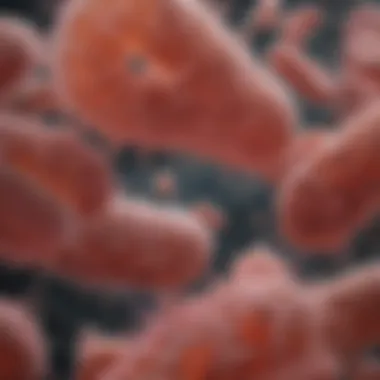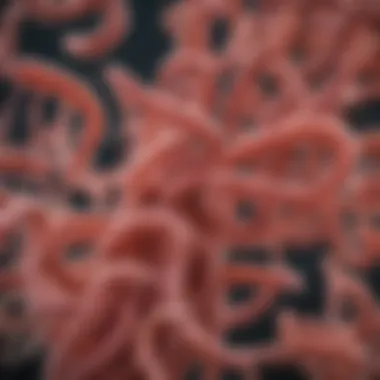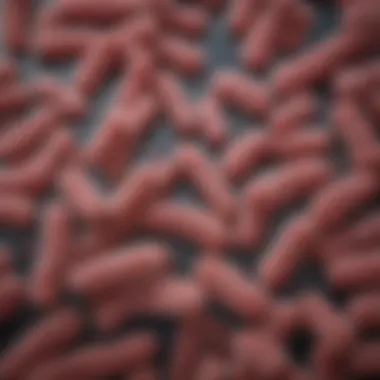Insights into E. coli K-12: Biology and Applications


Intro
In the vast realm of microbiology, few organisms have made as significant an impact as Escherichia coli K-12. This particular strain of E. coli, often revered as a workhorse in research laboratories worldwide, serves not just as a subject of study, but also as a foundational tool in various biotechnological applications. Grasping the biology of E. coli K-12 is crucial for students, researchers, educators, and professionals engaged in life sciences.
A myriad of factors contributes to its prominence; E. coli K-12 possesses traits ideal for genetic manipulation and experimentation. It has opened doors to key advancements in molecular biology, genetics, and biochemistry. The sheer versatility of this bacterium goes beyond basic understanding—entering into the realms of bioengineering, drug development, and even synthetic biology. This article aims to peel back the layers of knowledge surrounding E. coli K-12, revealing its multifaceted character and the implications of its use in scientific discourse today.
In the subsequent sections, we will explore its biological characteristics, the implications of its genetic modifications, its safety within laboratory environments, and the future directions of research—all underlining the importance of E. coli K-12 in contemporary science.
Let’s call a spade a spade: comprehending this organism is not merely academic; it's instrumental in fostering innovation in biotechnology and medicine. Thus, it’s time to dive deeper into the research highlights.
Prelude to E. coli K-12
The topic of E. coli K-12 is not merely a footnote in the annals of microbiology; it is the cornerstone of numerous scientific breakthroughs. Understood as a model organism, this particular strain of Escherichia coli has paved the way for significant advances in molecular biology, genetics, and biochemistry.
E. coli K-12’s relevance stretches across various scientific fields, making it indispensable in laboratory research and academic settings. It serves as a prime example for exploring genetic manipulation, which opens a whole treasure chest of possibilities in synthetic biology and biotechnology applications.
One of the most compelling aspects of this strain is its relative safety compared to other strains of E. coli that are notorious for causing diseases. Studying it allows researchers to dissect biological mechanisms without the heightened risk associated with pathogenic variants. The implications of understanding this strain go beyond academia into realms such as industrial processes, vaccine development, and even environmental science.
Historical Background
E. coli K-12 has a rich history that showcases its importance in scientific research. Originally isolated in the early 20th century, K-12 emerged as the subject of study because of its manageable characteristics and the ease with which it can be modified genetically.
The strain was developed and widely adopted in laboratories during the 1960s and 70s, a period that saw rapid advancements in recombinant DNA technology. Scientists successfully manipulated its genetic material, thus developing foundational technologies that are still in use today.
"The strides made in genetic engineering during the late 20th century owe much to the study of E. coli K-12."
In retrospect, the history of E. coli K-12 is also entwined with the development of the first cloning vectors and plasmids. Such tools provided researchers with the means to replicate DNA sequences efficiently, a practice that became essential for many subsequent discoveries.
Definition and Classification
Understanding what categorizes E. coli K-12 is crucial for contextualizing its role in genetic and biotechnological research. Formally, E. coli belongs to the family Enterobacteriaceae. K-12 denotes a specific laboratory strain of E. coli that has been genetically determined and characterized.
In terms of classification, E. coli K-12 is referred to as a Gram-negative, rod-shaped bacterium. The strain is non-pathogenic and differs significantly from other strains that can cause foodborne illness. This distinction is essential, especially for applications involving genetic modification and synthetic biology.
Moreover, K-12 has gained a reputation for its well-mapped genome, having been one of the first organisms to have its entire genetic code sequenced. Its simplicity makes it perfect for laboratory experiments, allowing for the investigation of genetic expressions and cellular processes.
In summary, the importance of E. coli K-12 in scientific research cannot be understated, as it encompasses a wide range of applications while boasting a fascinating historical background.
Genetic Characteristics of E. coli K-12
The genetic characteristics of E. coli K-12 are pivotal for understanding its role as a model organism in research. This strain, derived from the wild-type E. coli that is commonly found in the intestinal tract of humans and other animals, has undergone significant genetic modifications that emphasize its benefits in laboratory contexts.
Through the lens of our examination, one can appreciate not merely the underlying genetic makeup but also the way in which these traits facilitate advances in a variety of scientific domains, such as molecular biology and genetic engineering. Thus, delving into the genetic basis of E. coli K-12 provides a foundation for its applications and implications across a spectrum of biotechnological innovations.
Genomic Structure
E. coli K-12 possesses a well-defined Genomic Structure that lends itself to scrutiny by researchers. Its genome consists of approximately 4.6 million base pairs, providing a rich tapestry of genetic information vital for its growth, metabolism, and adaptability. The chromosomal DNA is a circular molecule, and the compact nature of the E. coli genome allows for efficient regulation and expression of genes.
Here are some key elements of the genomic structure:
- Compact Genome: With around 4,300 protein-coding genes, the E. coli K-12 genome is remarkably efficient, using nearly every gene for crucial cellular processes.
- Operons: Many genes are clustered in operons, allowing for coordinated regulation. This characteristic is useful for studies on gene expression and interactions.
- Regulatory Elements: The presence of various promoter regions and ribosomal binding sites enables adaptability to different environmental stresses, making this organism a model for studying gene regulation.
The genomic features of E. coli K-12 facilitate techniques such as sequencing, where researchers can uncover extensive data on genetic functions and interactions. These insights can pave the way for innovations in genetic therapies and synthetic biology.


Plasmids and Genetic Tools
Plasmids are circular DNA molecules independent of chromosomal DNA, and they play an essential role in the versatility of E. coli K-12. This organism is famed for its ability to accommodate various plasmids, which can carry genes of interest. These plasmids serve as fundamental tools in genetic engineering and molecular cloning.
Here are some critical aspects regarding plasmids and genetic tools related to E. coli K-12:
- Natural Plasmids: E. coli naturally harbors plasmids, such as the F (fertility) plasmid, which can be manipulated to transfer genetic material between bacteria.
- Recombinant Plasmids: Researchers can create recombinant plasmids, thus enabling the introduction of foreign genes into E. coli. This capability leads to the expression of proteins that can be harvested for various applications, including pharmaceuticals.
- Selectable Markers: Many plasmids contain markers like antibiotic resistance genes, allowing for easy identification of successful transformations, helping streamline research processes.
Utilizing plasmids enhances the capacity for genetic experimentation and synthesis, which showcases the adaptability of E. coli K-12 as an indispensable asset in biotechnology.
"Understanding the genetic framework of E. coli K-12 is essential not only for basic research but also for multiple applications in medicine, agriculture, and environmental science."
Laboratory Applications
E. coli K-12 is a quintessential workhorse in molecular biology labs worldwide. The reasons are manifold, particularly the organism's genetic tractability, rapid growth rate, and the wealth of genetic tools developed around it. This section highlights how E. coli K-12 serves various laboratory applications, specifically in molecular cloning, protein expression, and gene editing. Understanding these applications provides invaluable insights into the direct contributions of E. coli K-12 to scientific progress.
Molecular Cloning
Molecular cloning is a technique central to genetic research, allowing scientists to manipulate DNA by isolating specific genes or sequences. E. coli K-12 became an ideal host for cloning due to its well-characterized genetics and ease of transformation with plasmid vectors.
Researchers often utilize restricted enzymes to cut both vector and target DNA, followed by ligation to form recombinant DNA. This crafted DNA can then be introduced into E. coli K-12 cells, where it replicates as the bacteria grow.
- Advantages of using E. coli K-12 in molecular cloning include:
- Rapid cell division, enabling quick results.
- High transformation efficiency, meaning more cells take up the foreign DNA.
- A plethora of well-documented plasmids.
This system is not perfect, of course. There's a necessity to ensure the compatibility of vectors and the target DNA, and one needs to be cautious of the possible occurrence of unwanted mutations during replication. Moreover, while E. coli K-12 is generally safe, improper handling can lead to contamination, illustrating the need for stringent safety protocols.
Protein Expression Systems
E. coli K-12 is the star player when it comes to expressing proteins. This bacterium is particularly advantageous for producing recombinant proteins due to its straightforward growth conditions and the scalability of culture processes.
When scientists want to produce a specific protein, they typically insert the gene coding for that protein into the bacterial genome or a plasmid. E. coli K-12 can synthesize proteins quickly, making it possible to harvest them in just a few days.
Using E. coli, researchers can generate proteins that are difficult or expensive to obtain from natural sources. The proteins produced often require additional modifications like glycosylation, which E. coli cannot perform. However, for many applications, such as enzyme production or affinity tags, E. coli K-12 works beautifully.
Gene Editing and Synthetic Biology
The advent of CRISPR technology has transformed the landscape of genetic engineering. E. coli K-12 plays a vital role in the application of this technology.
Researchers can easily integrate CRISPR systems into E. coli K-12 to create custom strains. For example, by designing guide RNAs that direct the Cas9 enzyme to specific DNA sequences, scientists can make precise edits in the bacterial genome. This has opened doors for new avenues in synthetic biology, where the goal is to design organisms with novel functionalities.
The implications are grand. Imagine engineered strains of E. coli K-12 capable of bio-manufacturing drugs or biodegradable plastics. These applications not only present scientific curiosity but also potential solutions to pressing environmental issues.
In summary, E. coli K-12 has cemented itself as an indispensable ally in the laboratory, facilitating a wealth of investigations in genetic engineering, molecular cloning, and protein synthesis. Its widespread use underscores the critical importance of this model organism in bridging the gap between basic research and practical application.
"The power of E. coli K-12 in the lab is akin to having a Swiss Army knife at your disposal—versatile, reliable, and absolutely essential for advancing our understanding of life at the molecular level."
This comprehensive examination of the laboratory applications of E. coli K-12 not only highlights its utility but serves as a testament to the organism's pivotal role in modern scientific inquiry.
Safety and Risk Assessment
The significance of safety and risk assessment in the context of E. coli K-12 cannot be overstated. In laboratories around the globe, researchers must navigate the fine line between leveraging the potential of this model organism and ensuring the safety of staff, the environment, and public health. A proactive approach in assessing risks associated with working with E. coli K-12 helps maintain strict safety protocols and adhere to regulatory guidelines, which ultimately facilitate groundbreaking research while minimizing hazards.


Biological Safety Levels
Biological Safety Levels (BSLs) are a classification system designed to indicate the level of containment required when handling different biological agents, including E. coli K-12. These levels range from BSL-1, for agents that pose minimal threat to individuals and the environment, to BSL-4, reserved for the most dangerous organisms. E. coli K-12 is classified as BSL-1, meaning it is among the least hazardous strains of E. coli that researchers encounter.
- BSL-1 measures include:
- Work should be performed in a basic laboratory setting.
- Standard laboratory practices must be strictly followed.
- Personal protective equipment, such as gloves and lab coats, should be utilized if exposure is a risk.
This classification ensures a foundational layer of protection which, although minimal for E. coli K-12, underscores the necessity of following procedures that guard against contamination and other unintended consequences. As the strains evolve and researchers may venture into genetically modified territories, moving up to BSL-2 protocols can become necessary, especially if the modifications might influence virulence or pathogenic properties.
"When researching genetic modifications, always assess the possible implications and risks to maintain safe laboratory environments."
Handling and Disposal Regulations
Safety doesn't stop at containment. Handling and disposal regulations are equally pivotal in managing any potential risks associated with E. coli K-12 research. By following established guidelines, researchers can prevent accidental spills or releases into the environment. Key aspects of these regulations involve:
- Storage:
- Disposal:
- Decontamination:
- Use well-sealed containers for both live cultures and waste.
- Label all samples with pertinent information like the strain number and the date of preparation.
- Autoclave all biohazard waste before disposal to eliminate any viable organisms.
- Dispose of chemical or hazardous waste according to local regulations to prevent environmental contamination.
- Always clean surfaces with appropriate disinfectants after use to mitigate any risk of contamination.
Abiding by these regulations fosters a culture of responsibility in laboratories and highlights the importance of accountability when engaging with powerful tools such as E. coli K-12. The commitment to safety not only protects research teams but also safeguards broader communities, reinforcing the vital need for diligent risk assessments in this field.
E. coli K-12 in Biotechnology
The versatility of Escherichia coli K-12 has made it a cornerstone in biotechnology. This remarkable strain has found its way into various applications, driving innovations in fields like molecular biology, genetic engineering, and industrial manufacturing. With a well-characterized genome and a robust set of tools for manipulation, E. coli K-12 is often regarded as the workhorse of the laboratory. Given its significant impact on biotechnological advancements, understanding its utility, along with its benefits and limitations, is essential for anyone engaging with modern biotechnology.
Industrial Applications
E. coli K-12 serves as a vital player in industrial biotechnology. Its capabilities extend beyond mere académica familiarity into real-world applications that streamline production processes. One prominent use is in the synthesis of recombinant proteins. By inserting the gene of interest into the E. coli genome, scientists can produce large quantities of proteins for therapeutic purposes, such as insulin and antibodies. This not only addresses supply shortages but also reduces the cost associated with traditional purification methods.
Additionally, E. coli K-12 is instrumental in the production of biofuels and bioplastics. The bacterial strain can be engineered to metabolize various substrates, converting waste materials into valuable resources. For example, researchers have integrated pathways to enhance the ability of E. coli to ferment glucose into ethanol or to create biodegradable plastics, reducing environmental impact. This sustainable approach exemplifies how E. coli K-12 is at the forefront of eco-friendly industrial processes.
"E. coli K-12 isn’t just your average laboratory organism; it’s a key player in a sustainable future through its applications in biofuel and bioplastics production."
Moreover, the adaptability of E. coli in high-density fermentation processes allows for improved efficiency in manufacturing. Companies leverage its growth rates and yield potentials to optimize production lines, making the bacterium a prime candidate in the push for greener and more efficient biotechnological solutions.
Vaccine Development
The role of E. coli K-12 in vaccine development cannot be overstated. Its safety and well-defined genetic background have allowed researchers to use it as a platform for producing vaccine components. By harnessing this strain, scientists can develop subunit vaccines that elicit specific immune responses without risking exposure to pathogenic organisms.
One of the remarkable achievements in this area has been the production of the hepatitis B vaccine. Utilizing recombinant DNA technology, E. coli K-12 was engineered to produce the surface antigen of the hepatitis B virus, which, once purified, proved effective as a safe vaccination strategy. This approach paved the way for more comprehensive research into vaccine development leveraging E. coli as a production host.
Furthermore, E. coli's capacity for rapid growth and easy cultivation makes it an ideal candidate for large-scale vaccine production. The strain can be grown quickly in fermentation tanks, allowing pharmaceutical companies to respond rapidly to public health needs. This agility is particularly valuable in managing emerging diseases or outbreaks, ensuring that safe and effective vaccines can be produced in a timely manner.
As the field of biotechnology continues to evolve, the role of E. coli K-12 remains crucial. Its applications in industry and vaccine development showcase the strain's potential to contribute significantly to human health and environmental sustainability. Researchers are consistently exploring new ways to leverage its capabilities, hinting at an exciting trajectory ahead for this remarkable organism.
Ethical Considerations
The discussion around ethical considerations when working with Escherichia coli K-12 is crucial. As a model organism widely used in molecular biology, having a clear understanding of the associated ethical implications is not just important—it's essential. Many of these ethical concerns revolve around genetic modification and the broader societal ramifications that arise from scientific advancements facilitated by this bacterium.


Genetic Modification Ethics
When it comes to genetic modification ethics, E. coli K-12 serves as a prime example. Researchers harness its genetic makeup for various purposes, including therapeutic protein production and gene editing. These activities raise a few pressing questions. For starters, is it right to manipulate an organism’s genetic structure? Moreover, who bears responsibility if something goes awry?
The answers are not black-and-white. From a practical standpoint, genetic modification allows for the creation of medicinal solutions, like insulin production, which has transformed diabetes treatment. However, some people argue that advancing technology can lead to unforeseen consequences. This concern is particularly relevant in genetic engineering. As scientists alter DNA, they tread a thin line between innovation and potential disruption of natural ecosystems. Consider how genetically modified organisms can crossbreed with wild types, leading to unpredictable ecological impacts.
Here are some common themes found in the conversation about genetic modification ethics involving E. coli K-12:
- Benefits: Addressing global challenges like food scarcity, disease management, and environmental cleanup.
- Risks: Potential long-term effects on biodiversity or human health that remain unknown.
- Transparency & Accountability: Necessity for clear guidelines governing the manipulation of genetic materials to ensure public trust.
Impacts on Environment and Society
The impacts on environment and society cannot be understated. As E. coli K-12 continues to find innovative applications in laboratories, the broader implications ripple through various domains. For instance, while creating biodegradable plastics or enhancing agricultural practices, researchers must consider the ecological footprint of such interventions.
Environmental impacts can vary widely:
- Positive Effects: Bioremediation, a process utilizing E. coli K-12 to break down pollutants, presents an avenue for addressing contamination issues in soil and water.
- Negative Effects: The introduction of engineered strains into natural habitats may lead to ecological imbalance, which some scientists find concerning.
The societal aspect deals with public perception and acceptance of biotechnology—this is essential. Many communities may express anxiety over genetic technologies due to misinformation. If society does not trust these scientific advancements, it can hinder progress and the acceptance of potentially life-saving solutions. This is particularly relevant when considering community engagement in discussions around legislation and policy.
"The most profound ethical dilemmas often arise from our attempts to alter the very fabric of life itself."
Future Perspectives
The discussion around Future Perspectives regarding E. coli K-12 is pivotal in understanding its potential trajectory in various fields. As a versatile model organism, E. coli K-12 opens doors to numerous pathways in research and application. The implications extend beyond just academic environments; they resonate in industrial settings, medical advancements, and societal impacts. The significance of this topic lies in several aspects, including ongoing research developments, the role of biotechnology, and ethics in genetic advancements.
Advancements in Research
Recent years have witnessed remarkable strides in research centered on E. coli K-12. Advances in sequencing technologies have allowed for more intricate mapping of its genome. This genetic insight drives numerous projects aimed at boosting productivity in biomanufacturing. For instance, labs are exploring the modification of E. coli K-12 to produce biofuels more efficiently. With this organism's robust adaptability, there's potential for significant enhancements in industrial applications.
Moreover, the rise of CRISPR-Cas9 technology has provided researchers with the tools to edit genes with unprecedented precision. This has led to a surge of interest in utilizing E. coli K-12 for gene-editing experiments. Scientists are now capable of crafting custom vaccine platforms aimed at tackling emerging diseases. The prospects here are not only promising for human health but also for agriculture, as genetically modified strains of this bacterium can be developed to improve crop resilience.
Potential Innovations
Looking ahead, the innovative potential of E. coli K-12 seems boundless. The integration of artificial intelligence in genetic research is paving the way for predictive modeling. By leveraging computational power, researchers can predict how specific genes will behave when altered. This can maximize efficiency and reduce trial-and-error, which has traditionally slowed the pace of innovation.
Furthermore, the rise of synthetic biology relies heavily on organisms like E. coli K-12. Through metabolic engineering, there’s potential to create bacteria that can produce high-value chemicals, pharmaceuticals, and even biodegradable plastics. The idea of sustainable development runs deep in these innovations, highlighting the need for more environmentally friendly production methods.
Innovations in E. coli K-12 research signal a future where biochemical production aligns with the goals of sustainability and health, reflecting broader societal objectives.
In summary, the future of E. coli K-12 is brimming with promise. As research methodologies advance and innovative applications emerge, the versatile bacterium’s role will undoubtedly expand. The intersection of biological research, technology, and ethical considerations will shape how E. coli K-12 is utilized in the years to come.
Finale
The conclusion serves as the final touchstone of our exploration into E. coli K-12, tying together the various strands of information presented throughout the article. Understanding this organism is not merely an academic pursuit; it is a gateway into the intricate workings of molecular biology, biotechnology, and genetic engineering. The significance of E. coli K-12 lies in its versatility and its role as a model organism that has shaped our advancements in various scientific fields.
Summary of Key Points
Recapturing the major themes discussed, we can summarize key points as follows:
- Historical Significance: E. coli K-12 has a rich background, having been studied extensively since its discovery.
- Genetic Diversity: It possesses a unique genomic structure that allows for easy manipulation, making it an essential tool for molecular cloning and gene editing.
- Laboratory Applications: Its role in protein expression systems and synthetic biology has opened new avenues for scientific research.
- Safety Factors: Understanding its biological safety levels and disposal regulations is crucial in mitigating risks associated with laboratory work.
- Biotechnological Impact: E. coli K-12 continues to play a pivotal role in vaccine development and industrial applications.
- Ethical Considerations: The implications of genetic modifications involve a careful analysis of ethical responsibilities towards society and nature.
Final Thoughts
As we contemplate the future of E. coli K-12, it is clear that its contributions are vast and varied. Researchers and practitioners must remain vigilant about its ethical implications while embracing new advancements in genetic technology. The landscape of biotechnology is evolving, and as more innovative applications emerge, E. coli K-12 will likely remain at the forefront.
"E. coli K-12 embodies the spirit of scientific inquiry, reflecting our constant quest to leverage biology for the betterment of humanity."
In summary, E. coli K-12 is more than just a bacterial strain; it is a keystone in the edifice of modern science. Whether one is a student, researcher, or educator, understanding its biology and applications is essential for engaging meaningfully with contemporary issues in biotechnology and genetics.







